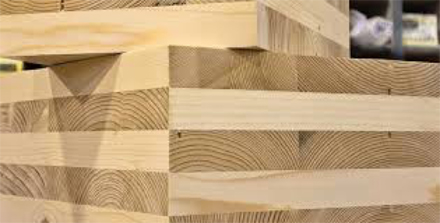
The global cross laminated timber (CLT) market expected to reach USD1606 million in 2024, growing at a CAGR of 15% between 2018 and 2024. The cross laminated timber (CLT) market is likely to be driven by rising product demand for construction and building applications, due to its cost-effectiveness and sustainability concerns in the forecast period. Source: Timberbiz
Zion Market Research has published a new report titled “Cross Laminated Timber (CLT) Market By Type (Adhesive Bonded CLT and Mechanically Fastened CLT) and By Application (Residential Buildings, Educational Institutes, Government/Public Buildings, and Industrial and Commercial Spaces): Global Industry Perspective, Comprehensive Analysis, and Forecast, 2017 – 2024”.
According to the report, the global cross laminated timber (CLT) market was valued at USD 603 million in 2017 and is expected to reach USD 1606 million in 2024, growing at a CAGR of 15% between 2018 and 2024.
The cross laminated timber (CLT) market is likely to be driven by rising product demand for construction and building applications, due to its cost-effectiveness and sustainability concerns in the forecast period. However, moisture trapping and wetting potential in certain climatic conditions might impede this market.
Nevertheless, new market avenues are likely to create new opportunities in the global cross laminated timber (CLT) market in the years to come.
The cross laminated timber (CLT) market is divided based on the type and application.
By type, the market is split into adhesive bonded CLT and mechanically fastened CLT. Adhesive bonded held the largest market share in 2017 and is projected to dominate over the projected years. This can be attributed to its seismic performance and great strength. However, growing environmental awareness for adhesive usage, owing to its carbon emission properties might impede this segment’s demand.
By application, the cross laminated timber (CLT) market is segmented into residential buildings, educational institutes, government/public buildings, and industrial and commercial spaces.
Residential buildings held the largest market share in 2017, around 50%. The demand for wooden residential buildings including multi-family apartments and single-family homes is rising owing to their design flexibility and aesthetic appeal.
The earthquake-proof and improved fire resistance qualities of CLT homes are anticipated to drive the market in the upcoming years.
By geography, Europe dominated the global cross laminated timber (CLT) market and accounted for around 60% market share in 2017. The presence of major manufacturers, such as Mayr-MelnhofHolz Holding AG, Stora Enso, Binderholz Bausysteme GmbH, HASSLACHER Holding GmbH, and KLH Massivholz GmbH, in Europe is attracting a large number of CLT customers.
The consumption of CLT in Germany is higher than in other countries, due to CLT’s widespread acceptance among builders and architects.
In the Asia Pacific, New Zealand, Australia, and Japan are major consumers of CLT. Earthquake-prone countries, such as Japan and India, have shown significant interest in using cross laminated timber as a construction material for residential and non-residential buildings.
North America’s CLT demand was valued around USD 130.8 million in 2017, owing to the rising CLT use in residential and institutional applications. Increasing consumer demand for luxury and stylish apartments is anticipated to fuel this industry’s growth.
The growing CLT use in residential applications, including floors, ceilings, and walls, is also estimated to drive this market. This region is projected to be the second largest market in the future.
The Middle Eastern and African and Latin American regions are expected to witness moderate growth over the forecast time period, owing to the increase in construction activities and rapid industrial development.
The key manufacturers of the cross laminated timber (CLT) market are Stora Enso, KLH Massivholz GmbH, Binderholz Bausysteme GmbH, HASSLACHER Holding GmbH, Mayr- MelnhofHolz Holding AG, Structurlam Mass Timber Corporation, Eugen Decker Holzindustrie KG, Nordic Structures, Sterling Lumber Company, Ed. Zueblin AG, and W. u. J. Derix GmbH & Co.







